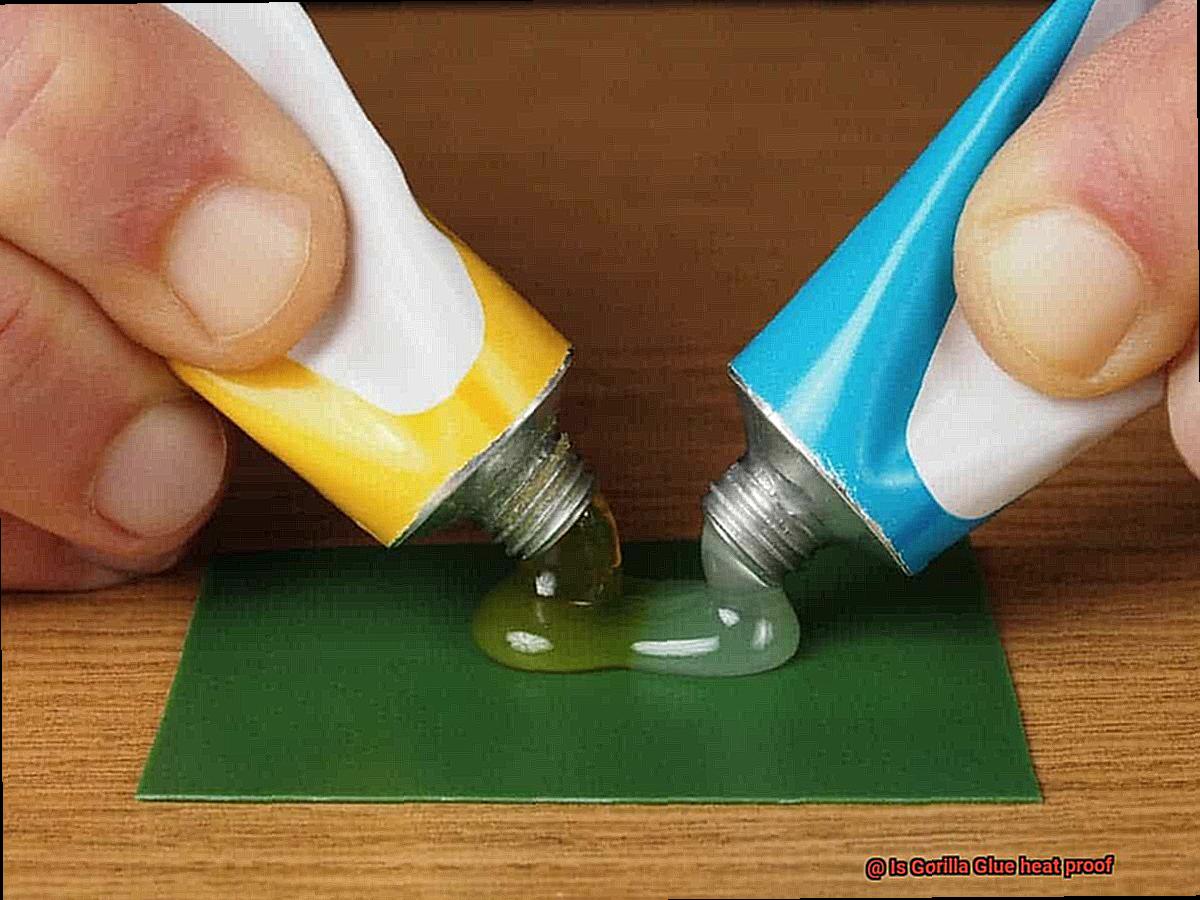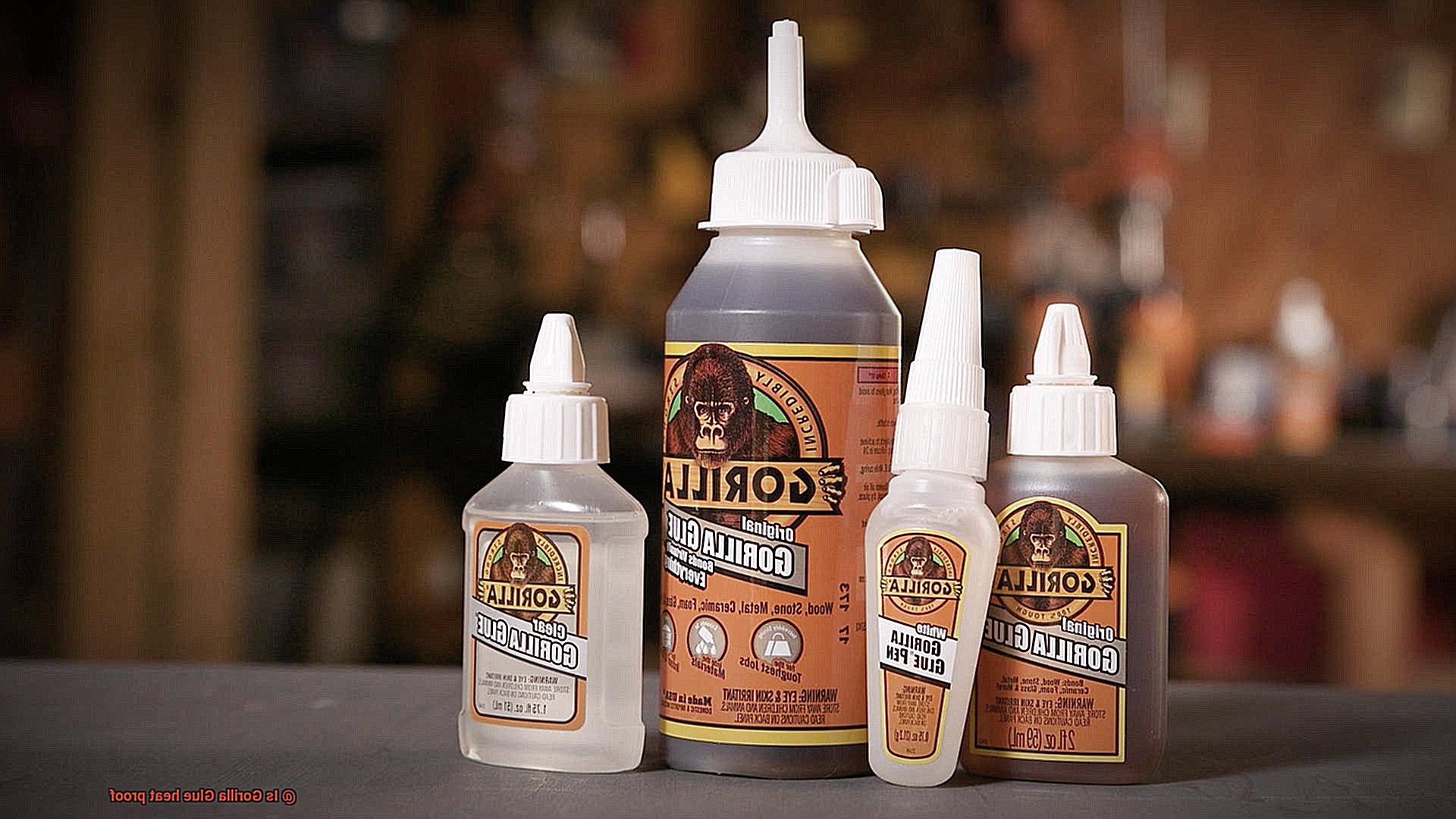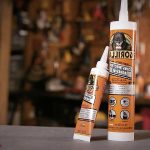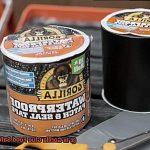TWelcome to our blog, where we’re about to tackle a hot topic that has left many DIY enthusiasts and craftsmen scratching their heads: Can Gorilla Glue handle the heat?
In the adhesive realm, Gorilla Glue reigns supreme, known for its exceptional strength and adaptability. But when it comes to facing scorching temperatures, doubts start to simmer. Will this adhesive stand tall in the face of blistering heat or crumble like a burnt cookie?
Fear not. We’re here to extinguish any misconceptions surrounding Gorilla Glue’s heat resistance. Whether you’re a DIY aficionado, a construction connoisseur, or simply curious about this adhesive’s fiery fortitude, get ready as we dive into the truth behind Gorilla Glue and its ability to withstand sizzling temperatures.
What is Gorilla Glue?
Contents
- 1 What is Gorilla Glue?
- 2 Is Gorilla Glue Heatproof?
- 3 Factors to Consider When Evaluating Heat Resistance of Gorilla Glue
- 4 Temperature Tolerance of Gorilla Glue
- 5 Prolonged Exposure to High Temperatures and Its Effect on Gorilla Glue Bond Strength
- 6 Alternatives for High-Temperature Applications
- 7 Conclusion
When it comes to finding a reliable adhesive that can bond various materials together, Gorilla Glue is a name that stands out. This polyurethane adhesive has gained popularity for its exceptional strength, versatility, and durability. In this comprehensive guide, we will explore what makes Gorilla Glue so special and how it can be used for a wide range of projects.
Versatility and Bonding Capabilities:
Gorilla Glue is renowned for its ability to bond different surfaces, including wood, metal, stone, ceramic, and more. Its strong and durable bond is achieved through the glue’s unique expansion properties. When exposed to moisture, Gorilla Glue expands, filling in gaps and cracks to provide added stability. Whether you’re repairing broken furniture or creating a DIY masterpiece, this adhesive has got you covered.
Forms of Gorilla Glue:
To meet different project requirements, Gorilla Glue is available in three main forms:
- Liquid Glue: Perfect for larger projects, the liquid glue can be easily applied using a brush or spreader. It provides ample time for repositioning before it dries and forms a strong bond.
- Super Glue: Ideal for smaller repairs and quick fixes, the super glue bonds surfaces together in seconds. Its precision applicator ensures precise application without any mess.
- Glue Sticks: Convenient for on-the-go fixes, glue sticks are easy to use without the need for additional tools or equipment. Simply apply the glue stick directly onto the surface.
Waterproof and Weather-Resistant:
In addition to its exceptional bonding capabilities, Gorilla Glue is also known for its resistance to water and extreme temperatures. Once cured, this adhesive becomes waterproof, making it suitable for both indoor and outdoor applications. It can withstand exposure to water without compromising its adhesive properties, ensuring that your projects stay intact even under challenging conditions.
Heat Resistance:
While Gorilla Glue offers moderate heat resistance, it is not heatproof. It can withstand temperatures up to 140°F (60°C) without significant loss of bond strength. However, prolonged exposure to high temperatures can weaken the adhesive. If you require an adhesive for high-temperature applications, consider specialized heat-resistant adhesives designed for such purposes.
Is Gorilla Glue Heatproof?
Gorilla Glue, renowned for its exceptional bonding capabilities, has become a household name. But when it comes to high temperatures, can it withstand the heat? The answer, in short, is yes – to a certain extent. Gorilla Glue is indeed heat resistant, but it does have its limitations that need to be considered.
When cured properly, Gorilla Glue can withstand temperatures of up to 200°F (93°C). This means it can endure brief exposure to high heat without compromising its bond strength. However, it’s important to bear in mind that prolonged heat exposure can lead to the degradation and eventual failure of the glue. Therefore, while Gorilla Glue can handle moderate heat, it is not suitable for extreme temperatures or applications that involve continuous exposure to heat.
The heat resistance of Gorilla Glue may vary depending on the specific product variant. For instance, Gorilla Super Glue Gel is formulated to withstand temperatures of up to 220°F (104°C), making it slightly more heat resistant than the original Gorilla Glue.
To ensure optimal heat resistance, it is crucial to follow the manufacturer’s instructions for curing and using Gorilla Glue. Proper application and adequate curing time are essential in achieving maximum bond strength and heat resistance.
In cases where higher heat resistance is required, specialized heat-resistant adhesives or sealants might be more suitable. These products are specifically designed to withstand extreme temperatures and provide long-lasting bonds under challenging conditions.
Therefore, if you are working on a project that involves heat exposure, it is recommended to test a small area first or consult the manufacturer’s guidelines to ensure Gorilla Glue’s compatibility with the specific temperature range.
In conclusion, while Gorilla Glue offers decent heat resistance compared to regular glues, it is essential to consider its limitations and select the appropriate adhesive for applications involving high temperatures. Always prioritize safety and adhere to the manufacturer’s instructions for optimal results.
Factors to Consider When Evaluating Heat Resistance of Gorilla Glue
When evaluating the heat resistance of Gorilla Glue, there are several key factors to consider. These factors can help determine if the glue is suitable for your specific application and if it will be able to withstand the heat without compromising its bond strength.
The first factor to consider is the temperature range that the Gorilla Glue can withstand. Different types of Gorilla Glue products may have varying heat resistance capabilities, so it is important to refer to the specific product’s instructions or technical data sheet for accurate information. Generally, Gorilla Glue is designed to be heat resistant up to a certain temperature, which can range from around 200°F (93°C) to 600°F (315°C), depending on the product.
Another important factor to consider is the bond strength of Gorilla Glue under heat. While the glue may be able to withstand high temperatures, it is essential to ensure that the bond between the glued surfaces remains intact and strong. The adhesive should not weaken or fail when exposed to heat, as this can result in structural integrity issues or product failure. To determine the bond strength, it is advisable to test the glue under elevated temperatures before using it in applications that involve exposure to heat.
The application method used for Gorilla Glue can also influence its heat resistance. Proper application techniques, such as applying an even layer of glue and ensuring good contact between the surfaces being bonded, can enhance the overall performance of the glue under heat. It is important to follow the manufacturer’s instructions regarding application methods and curing times to ensure optimal heat resistance.

Additionally, the type of material or substrate being bonded with Gorilla Glue can impact its heat resistance. While Gorilla Glue is suitable for a wide range of materials, including wood, metal, ceramics, and most plastics, some substrates may have different thermal expansion coefficients or temperature limitations. Considering the compatibility between the adhesive and the substrate is crucial when evaluating its heat resistance capabilities.

Apart from temperature and substrate compatibility, other environmental factors can also affect the heat resistance of Gorilla Glue. Humidity, exposure to chemicals or solvents, and UV radiation can all influence the glue’s performance under elevated temperatures. Understanding the specific environmental conditions in which the adhesive will be used is essential to assess its suitability for heat-resistant applications.
To ensure reliable and accurate information about the heat resistance of Gorilla Glue, it is advisable to look for third-party testing and certifications. Some adhesive manufacturers conduct rigorous testing procedures to determine the performance characteristics of their products, including heat resistance. Certifications from recognized organizations can provide reassurance regarding the glue’s ability to withstand high temperatures.
Temperature Tolerance of Gorilla Glue
Renowned for its unparalleled strength and versatility, this adhesive has become a go-to solution for countless projects. But when exposed to high temperatures, can Gorilla Glue stand the heat? Let’s delve into the research and discover the truth.
Understanding Gorilla Glue’s Temperature Tolerance:
Gorilla Glue may not be heat proof, but it certainly knows how to handle elevated temperatures with grace.
The temperature tolerance of Gorilla Glue can vary depending on the specific formula or type being used. For accurate information, always refer to the instructions or get in touch with the manufacturer.
Heat Resistance Facts:
Most types of Gorilla Glue can take the heat up to a scorching 200°F (93°C) when properly cured.
Curing is the process of drying and fully setting the glue. Once cured, the bond remains unyielding even in the face of blistering temperatures.
The Effect of Prolonged Exposure to High Temperatures:
Although Gorilla Glue exhibits decent heat resistance, extended exposure to extreme heat can gradually weaken its bond.
Intense heat can cause the glue to soften or degrade, potentially compromising its adhesive properties.
In outdoor applications where moisture and high temperatures combine forces, the bond may be further jeopardized.
Tips for Optimal Performance:
To ensure optimal performance in high-temperature applications, consider testing a small sample or seeking guidance from the manufacturer.
Follow the manufacturer’s instructions meticulously to achieve proper application and curing, maximizing Gorilla Glue’s temperature resistance.
Keep in mind that while Gorilla Glue is water-resistant, it is not entirely waterproof. If moisture is involved, take extra precautions to safeguard the bond.
Prolonged Exposure to High Temperatures and Its Effect on Gorilla Glue Bond Strength
When it comes to strong adhesives and versatile bonding solutions, Gorilla Glue is a household name. However, understanding its limitations is crucial, especially when faced with prolonged exposure to high temperatures. In this article, we will delve into the world of heat and its impact on the bond strength of Gorilla Glue. We will also provide tips to shield your glue from the blistering effects of heat.
Types of Glue Bonds:
To comprehend the repercussions of heat on Gorilla Glue, a grasp of glue bonds is essential. Mechanical, chemical, and adhesive bonds are among the different types. Gorilla Glue relies on a chemical reaction with moisture for its adhesive bond strength. Exposure to heat accelerates this reaction, causing the glue to cure faster than intended.
Environmental Factors that Affect Glue Performance:
Heat is not the sole environmental factor influencing glue performance. Humidity, substrate material, and application method also play a role. These variables impact the temperature threshold at which Gorilla Glue loses its effectiveness. Thus, considering these factors is vital when working with this adhesive.
The Impact of High Temperatures on Bond Strength:
Prolonged exposure to high temperatures can be detrimental to Gorilla Glue bond strength. Rapid curing due to heat may hinder the glue’s ability to form a robust bond with the materials it adheres to. Furthermore, high temperatures can soften the glue over time, resulting in weakened bonds and potential joint failure.
Protecting Gorilla Glue from Heat:
To ensure optimal bond strength and durability, precautions must be taken to shield Gorilla Glue bonds from excessive heat. Avoid subjecting glued materials to temperatures exceeding 150°F (65°C) for extended periods. If your project is anticipated to endure high temperatures, exploring alternative adhesives or specialized high-temperature adhesives designed for specific environments, such as automotive or aerospace applications, is advisable.
Alternatives for High-Temperature Applications
When it comes to high-temperature applications, Gorilla Glue might not be your best bet. While it’s known for its strength and versatility, it can start to degrade when exposed to extreme heat, leaving your project in a sticky situation. But fear not. There are plenty of alternatives out there that are specifically designed to withstand high temperatures and provide reliable bonding in even the hottest environments.
One alternative is epoxy resin, a superhero adhesive with exceptional heat resistance and durability. These adhesives can handle temperatures up to 300°F (150°C) or even higher, depending on the formulation. That’s why they’re commonly found in industries like aerospace, automotive, and electronics, where high temperatures are the norm.
If you need something even more heat-resistant, silicone adhesive is the way to go. These adhesives can withstand temperatures up to a scorching 500°F (260°C) or more. Not only do they handle extreme heat like champions, but they also offer excellent flexibility and resistance to chemicals, making them perfect for harsh environments.
But wait, there’s more. Ceramic-based adhesives are another fantastic choice for high-temperature applications. With temperature ranges from 2000°F (1093°C) to 3000°F (1649°C), these adhesives can handle the hottest of hot situations. They’re commonly used in furnaces, kilns, and exhaust systems where extreme heat and thermal cycling are expected.
And let’s not forget about specialty adhesives like polyimide and phenolic-based adhesives. Polyimide can withstand temperatures up to 500°F (260°C) or higher and is a favorite in the aerospace and electronics industries. Phenolic-based adhesives can handle temperatures up to 300°F (150°C) and are often used for bonding wood and laminates in high-temperature environments.
When selecting an adhesive for high-temperature applications, it’s crucial to consider factors like temperature range, exposure duration, substrate materials, and desired bond strength. Consulting with adhesive manufacturers or industry experts can help you choose the best adhesive for your specific needs.
01XSsJ3ki3M” >
Also Read: Will Gorilla Glue damage rubber?
Conclusion
In conclusion, Gorilla Glue offers decent heat resistance compared to regular glues, but it’s important to recognize its limitations and choose the right adhesive for high-temperature applications. Safety should always be a priority, so make sure to follow the manufacturer’s instructions for optimal results.
When properly cured, Gorilla Glue can withstand temperatures of up to 200°F (93°C). This means it can handle brief exposure to intense heat without compromising its bond strength. However, prolonged heat can weaken the adhesive and potentially cause bond failure.
It’s worth noting that the heat resistance of Gorilla Glue may vary depending on the specific product variant. For example, Gorilla Super Glue Gel is specially formulated to endure temperatures of up to 220°F (104°C), making it slightly more heat resistant than the original Gorilla Glue.
If you need an adhesive for high-temperature applications or continuous exposure to heat, consider using specialized heat-resistant adhesives or sealants. These products are specifically designed to tackle extreme temperatures and provide long-lasting bonds under challenging conditions.
When working with Gorilla Glue or any adhesive in hot environments, it’s crucial to test a small area first or consult the manufacturer’s guidelines. This ensures compatibility with your desired temperature range. Additionally, proper application techniques and sufficient curing time are essential for achieving maximum bond strength and heat resistance.
Remember, while Gorilla Glue is versatile and strong, it isn’t entirely heatproof.






